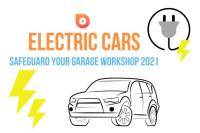 Add My Company
Add My Company
Sign In

In the race to solve the climate crisis, hybrid–electric and electric vehicles (EV) have become extremely popular. EV sales have risen by 66% since 2019.
It is safe to say that we have all encountered the uber quiet electric cars on the road by now and with this increase in buyers the number of EVs are, of course, also growing in repair shops. Due to their battery voltage, the risk of electrocution or static electricity causing a spark is high, therefore workers must be trained on how to safely service these types of vehicles.
Whilst it is likely that the current EV models will be taken to the original dealership to make repairs or for servicing, the local garage will also be adapting their solutions to provide for the EV boom.
Below our question and answer section is intended to make it easier for mechanics to understand the newrisks while working on hybrid–electric and electric vehicles, as well as find more information on which products are the best to protect them and their employees.
Electric Cars (EV) Questions and Answer
What are the main safety hazards for EV cars?
The main dangers in hybrid and electric vehicle repair are electrocution and the possibility of the car turning on accidentally while work is being performed. These serious risks make safety training a priority.
While some EV hybrids are easily recognisable, some are not necessarily distinguishable from their fuel-only counterparts. A mix-up could create serious problems for workers, sometimes resulting in life threatening hazards for those who are not able to tell the difference.
To address safety concerns, car companies have developed certain indicators that can help workers identify the vehicles:
Colour-coded high voltage cables in hybrid and electric vehicles warn of their potential danger. Usually these are orange, but some models have blue cables instead – check with the car manufacturer to identify the correct colour coding
What are the safety mechanisms?
Workers should avoid contact with high-voltage cables unless the high-voltage battery has been disconnected.
They should also ensure that the right PPE is worn when working on EV vehicles. Proper personal protective equipment (PPE) includes heavy, rubber, Class 0 rated gloves. Ordinary latex or neoprene shop gloves are NOT thick enough to protect against a high-voltage shock. Workers should inspect their gloves to make sure they do not have any pin holes, cracks, tears or splits that would allow direct contact between skin and voltage.
Other precautions include:
• Turning the ignition OFF and making sure that the key or key fob is away from the vehicle before it is serviced or repaired.
• Ensuring the READY light is NOT on.
• Waiting 15 minutes before working on the vehicle after the battery has been disconnected.
What are the EN standards for protective gloves with electrostatic testing?
The test requirements for BS EN 1149-1 & 3 are specified in BS EN 1149-5:2008, material performance and design requirements.
Do I need a specific fire extinguisher for EV fire risks?
Yes, regular car fires are usually put out using Powder Fire Extinguishers, however, a new risk assessment should be undertaken for EV vehicles.
Electrical fires with Lithium ion batteries should use a Lith-Ex Fire Extinguisher, they are effective against battery fires (mobile phones, tablets, laptops, toys, power tools and electric scooters etc).
What are the fire risks working on EV for mechanics?
Discharges (sparks) from the human body and from clothing can ignite flammable gas, vapours and dust clouds. Using anti-static clothing is a good way of reducing the risk alongside the normal fire prevention principles of separating ignition points from sources of fuel.
When you are working with electrical components, it is of the utmost importance to ensure that you are properly insulated against potential electrical shocks. The Rapid Fire Supplies range of Electricity Resistant Gloves are ideal for providing protection against electricity with products such as latex gloves, nitrile gloves and cotton gloves that offer insulation and prevent conductivity.
Suitable for electricians and electrical engineers, our Electricity Resistant Gloves range has a wide selection of different gloves, allowing you to find a pair that are well suited to your specific needs. Certain gloves have a disposable design while others are suited to repeated use without deterioration – please check individual pages for information on properties and suitability of the Electricity Resistant Gloves.
Most of the gloves within our ESD glove range are available in a number of different sizes, allowing you to find one with a great fit. As many electrical tasks require fine motor skills, finding a pair of gloves that won’t impede your dexterity is of the utmost importance. Gloves that are too small can constrict movement while gloves that are overly large can swamp your hands and prevent you from performing intricate movements
CONCLUSION
It looks like electric and hybrid-electric vehicles are here to stay and we can expect to see many more of them on our roads in the future. Keeping on top of ever-changing trends is essential to protect yourself and others against new potential dangers. Yes, gloves are small and inexpensive, but the right glove could be the all-important PPE that saves your life.
The Rapid Fire Supplies customer care team are available to answer any questions that you might have about Electricity Resistant Gloves. Please call us between 8:30 and 19:00, Monday to Friday on 03330 150 330 or alternatively leave us a message.
For more information on Electric Cars (EV) – Safeguard Your Garage Workshop 2021 talk to Rapid Fire Supplies
Enquire Now
List your company on FindTheNeedle.
